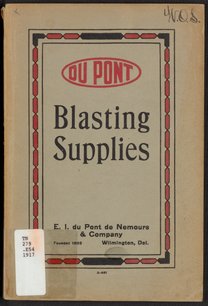Blasting Accessories
A Description of the Various Accessories Needed for Firing Charges of Explosives Together with some Explanation of the Best Methods of Using These Accessories
- 1925

Rights
Download all 82 images
PDFZIPof full-sized JPGsDownload selected image
Small JPG1200 x 1773px — 409 KBFull-sized JPG2532 x 3740px — 1.8 MBOriginal fileTIFF — 2532 x 3740px — 27.1 MBBooklet describing the Explosives Service of the Du Pont Company. The work describes products manufactured by the Du Pont Company related to blasting accessories, in particular, blasting caps, safety fuses, cap crimpers, blasting machines, igniters, wires, galvanometers, rheostats, and more. The booklet thoroughly describes each product, providing applications and instructions for their use and instructing when to use and how to care for the various instruments.
| Property | Value |
|---|---|
| Author | |
| Publisher | |
| Place of publication | |
| Format | |
| Genre | |
| Extent |
|
| Language | |
| Subject | |
| Rights | Public Domain Mark 1.0 |
| Credit line |
|
Institutional location
| Department | |
|---|---|
| Collection | |
| Physical container |
|
Related Items
Cite as
E.I. du Pont de Nemours & Company. “Blasting Accessories.” Wilmington, Delaware: E.I. du Pont de Nemours & Company, 1925. TN279 .E54 1925. Science History Institute. Philadelphia. https://digital.sciencehistory.org/works/hkrq57n.
This citation is automatically generated and may contain errors.
Rights
Download all 82 images
Searchable PDFmay contain errorsZIPof full-sized JPGsDownload selected image
-
Keyboard Shortcuts
Previous image shift + or , Next image shift + or . Pan image Zoom in + or shift + Zoom out - or shift + Zoom to fit 0 Close viewer esc Also
Mouse click to zoom in; shift-click to zoom out. Drag to pan. Pinch to zoom on touch.






















































